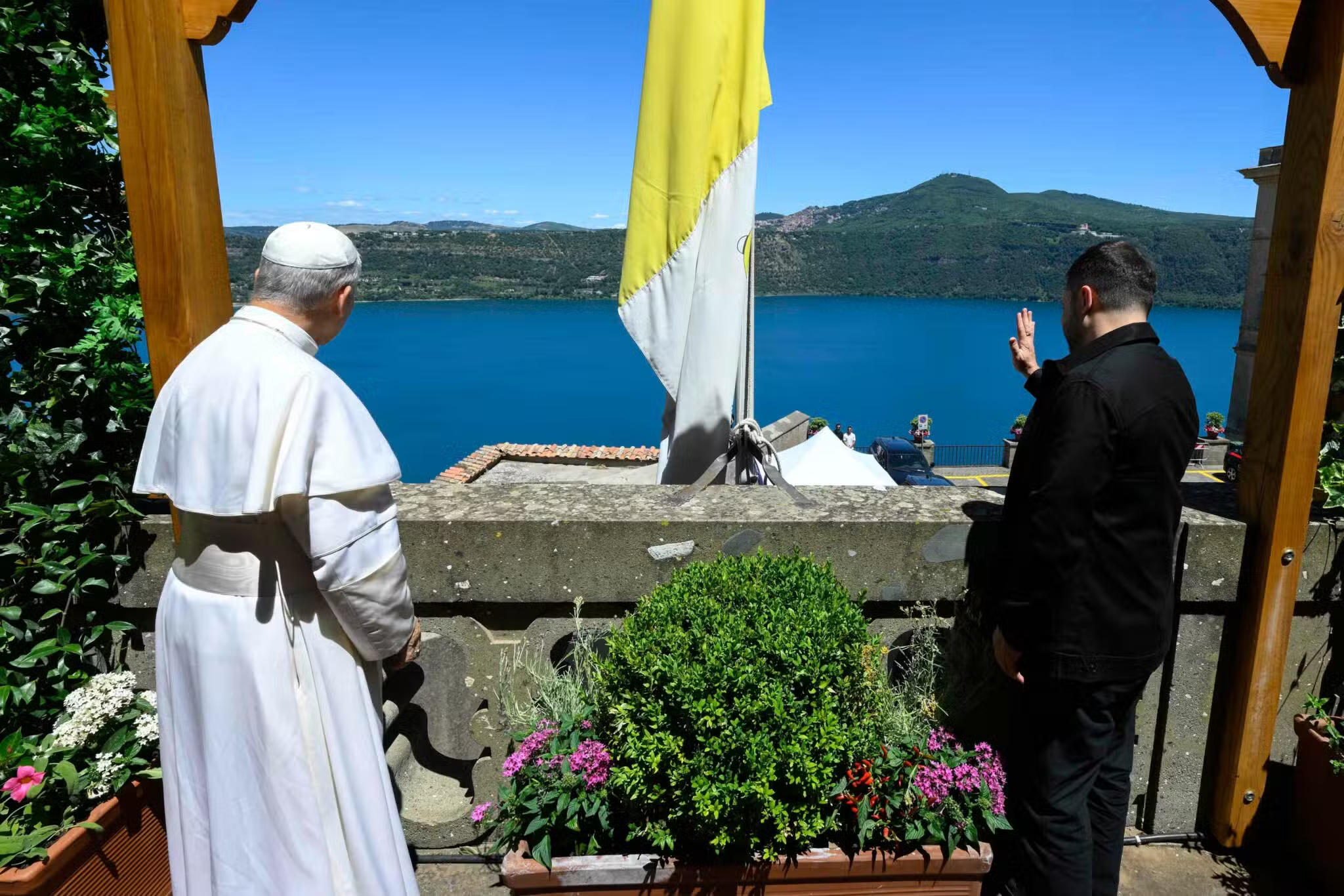BALTIMORE (OSV News) — Speaking to reporters outside the Cathedral of Mary Our Queen April 30 just moments before the Archdiocese of Baltimore held its final listening session on its Seek the City to Come parish reconfiguration proposal, Auxiliary Bishop Bruce A. Lewandowski, C.Ss.R., gestured to the grand stone building.
It’s feasible, the bishop said, that all the people who currently come to Mass at all the Catholic churches in the city could be housed at the cathedral for weekend Masses. The building seats more than 1,000, he said, and there are only a few thousand who attend Mass weekly in the city.
“We would never do that,” the bishop noted. “We want to be a neighborhood church, and we want to be in the communities where we are in the neighborhoods — and serve the communities that we’ve served for more than 200 years.”
Yet the illustration highlights the challenges the archdiocese faces as the number of Catholics in the city plummets, the number of people receiving the sacraments declines and old buildings require ever-increasing maintenance.
“This is difficult,” the bishop said. “It’s heart-wrenching. But we’re at a pivotal moment in the city church. We need to do this. We need to do this because our church membership is getting older, and we’re not replacing ourselves.”
Bishop Lewandowski said the archdiocese is continually evaluating the pros and cons of its proposed plan, which would reduce the number of worship sites in Baltimore City and some parts of Baltimore County from 59 to 26 and the number of area parishes from 61 to 21.
Archdiocesan leaders have already started making changes to the proposal as they take in feedback from well-attended listening sessions. Prior to the event at the cathedral, the archdiocese hosted a listening session at Archbishop Curley High School; one for Black Catholics at St. Frances Academy and another for Spanish-speaking Catholics at Our Lady of Fatima, all in Baltimore.
The bishop said the plan changes daily.
“We’re getting all kinds of suggestions — some good, some really good — and they make us go back to the table and say, ‘Wait a minute, we really need to look at what we’re doing here.’ There’s a lot of moving parts to it. Everything on the map has been looked at many times over. We’re really considering this and going through every detail with a fine-tooth comb,” Bishop Lewandowski said.
As at previous listening sessions, many attendees at the cathedral event were passionate about preserving their individual parishes. Many noted that their churches are anchors of their community, providing social outreach that they feared might disappear if their churches close.
When Geri Royale Byrd, co-director of Seek the City to Come, reviewed the proposal at the = beginning of the session, some attendees booed and jeered when their parishes were mentioned for possible consolidation with other faith communities.
Joan Huai was among a large group of parishioners of Our Lady of Victory in Arbutus who took three buses to the cathedral for the listening session. Many wore coordinated T-shirts and carried signs with their parish name.
They strongly opposed the Seek the City proposal to consolidate Our Lady of Victory with St. Agnes in Catonsville, St. Benedict in Baltimore, St. Joseph’s Monastery in Baltimore and St. William of York in Baltimore at the St. Agnes campus.
Huai noted that many of her parish’s members are immigrants from what is now Myanmar (Burma). She is a refugee who fled her native land in 2011 and found a sense of community at Our Lady of Victory.
“If we were to close, many of our members might choose to go to different churches and it won’t be possible for us to stay as a community anymore,” Huai told the Catholic Review, publication of the Archdiocese of Baltimore.
Other ethnic communities, including Filipinos, expressed similar concerns. Under the archdiocesan proposal, the Filipino community would be relocated from the Shrine of the Sacred Heart in Mount Washington to the Cathedral of Mary Our Queen, along with St. Pius X in Rodgers Forge and St. Thomas Aquinas in Hampden.
Julita Belches, a Filipino parishioner of the Shrine of the Sacred Heart, told the Catholic Review she is pleased the cathedral already hosts a special Filipino Mass once a year, but it doesn’t compare to the extensive ethnic ministry provided at her parish.
“If they move us to the cathedral, it’s a big switch,” she said. “This is like a plant that when you move it to the new environment, it will die at first. Then there’s a lot of challenges to move on to make it in such a way that it can survive. We hope the bishop will listen to our plea that we should remain as a stand-alone parish.”
Maria Nemcek, a parishioner of St. Clement Mary Hofbauer in Rosedale, chided the archdiocese for “not doing enough” to promote activities that might bring in more parishioners.
“We rely on families to kind of force their kids to go to church,” she said.
David Bender, pastoral council president of the Shrine of the Sacred Heart elicited some of the loudest cheers of the more than three-hour meeting.
“Respectfully, we do not agree with the proposal,” he said. “This proposal may make fiscal sense, but it does not make spiritual sense.”
Other speakers seemed to scold fellow Catholics attending the meeting for a lack of charity toward others.
“If we want to keep our church,” one woman said, “we have to show love.”
While the meeting continued, a steady stream of comments flowed from hundreds of people who were listening online during a livestream.
Maria Romero, a parishioner of Sacred Heart of Jesus-Sagrado Corazón de Jesús in Highlandtown who worships at her parish’s mission church of St. Patrick in Fells Point, wrote that she was saddened by St. Patrick’s proposed closure. But, she said, she understands the need for change.
Under the Seek the City proposal, Holy Rosary would combine with Sacred Heart of Jesus-Sagrado Corazón de Jesús and Our Lady of Pompei in Highlandtown (with the new parish to be based at Sacred Heart of Jesus), but Holy Rosary would remain open as a site
for Polish and Hispanic ministry.
“Currently, all of these 61 churches are islands,” Romero wrote, “islands trying to survive on their own by working individually, spending energy just to support ruined walls, old buildings, that have no life. However, if we all unite as brothers, we can work together to bring the Good News to people who need life and abundant life in Christ.”
Some Catholics have raised concerns about where the money from the sale of any closed properties will go. Bishop Lewandowski told reporters the funds will flow into the newly consolidated parishes.
“We need the funds from that property to strengthen the new parish,” he said. “And canon law tells us very strictly that if ever this would happen, the money follows the people to the new church that belongs to the people, to that congregation.”
Archbishop William E. Lori will evaluate input on the Seek the City proposal and consult with
a variety of groups as he discerns a final plan which is expected to be unveiled in mid-June.
The Archdiocese of Baltimore is made up of 137 parishes and eight missions in the city and nine Maryland counties. It serves nearly 504,000 Catholics.
By George Matysek Jr | OSV News







News & Commentary
Baltimore Catholics weigh-in on ‘heart-wrenching’ proposed changes in archdiocese
BALTIMORE (OSV News) — Speaking to reporters outside the Cathedral of Mary Our Queen April 30 just moments before the Archdiocese of Baltimore held its final listening session on its Seek the City to Come parish reconfiguration proposal, Auxiliary Bishop Bruce A. Lewandowski, C.Ss.R., gestured to the grand stone building.
It’s feasible, the bishop said, that all the people who currently come to Mass at all the Catholic churches in the city could be housed at the cathedral for weekend Masses. The building seats more than 1,000, he said, and there are only a few thousand who attend Mass weekly in the city.
“We would never do that,” the bishop noted. “We want to be a neighborhood church, and we want to be in the communities where we are in the neighborhoods — and serve the communities that we’ve served for more than 200 years.”
Yet the illustration highlights the challenges the archdiocese faces as the number of Catholics in the city plummets, the number of people receiving the sacraments declines and old buildings require ever-increasing maintenance.
“This is difficult,” the bishop said. “It’s heart-wrenching. But we’re at a pivotal moment in the city church. We need to do this. We need to do this because our church membership is getting older, and we’re not replacing ourselves.”
Bishop Lewandowski said the archdiocese is continually evaluating the pros and cons of its proposed plan, which would reduce the number of worship sites in Baltimore City and some parts of Baltimore County from 59 to 26 and the number of area parishes from 61 to 21.
Archdiocesan leaders have already started making changes to the proposal as they take in feedback from well-attended listening sessions. Prior to the event at the cathedral, the archdiocese hosted a listening session at Archbishop Curley High School; one for Black Catholics at St. Frances Academy and another for Spanish-speaking Catholics at Our Lady of Fatima, all in Baltimore.
The bishop said the plan changes daily.
“We’re getting all kinds of suggestions — some good, some really good — and they make us go back to the table and say, ‘Wait a minute, we really need to look at what we’re doing here.’ There’s a lot of moving parts to it. Everything on the map has been looked at many times over. We’re really considering this and going through every detail with a fine-tooth comb,” Bishop Lewandowski said.
As at previous listening sessions, many attendees at the cathedral event were passionate about preserving their individual parishes. Many noted that their churches are anchors of their community, providing social outreach that they feared might disappear if their churches close.
When Geri Royale Byrd, co-director of Seek the City to Come, reviewed the proposal at the = beginning of the session, some attendees booed and jeered when their parishes were mentioned for possible consolidation with other faith communities.
Joan Huai was among a large group of parishioners of Our Lady of Victory in Arbutus who took three buses to the cathedral for the listening session. Many wore coordinated T-shirts and carried signs with their parish name.
They strongly opposed the Seek the City proposal to consolidate Our Lady of Victory with St. Agnes in Catonsville, St. Benedict in Baltimore, St. Joseph’s Monastery in Baltimore and St. William of York in Baltimore at the St. Agnes campus.
Huai noted that many of her parish’s members are immigrants from what is now Myanmar (Burma). She is a refugee who fled her native land in 2011 and found a sense of community at Our Lady of Victory.
“If we were to close, many of our members might choose to go to different churches and it won’t be possible for us to stay as a community anymore,” Huai told the Catholic Review, publication of the Archdiocese of Baltimore.
Other ethnic communities, including Filipinos, expressed similar concerns. Under the archdiocesan proposal, the Filipino community would be relocated from the Shrine of the Sacred Heart in Mount Washington to the Cathedral of Mary Our Queen, along with St. Pius X in Rodgers Forge and St. Thomas Aquinas in Hampden.
Julita Belches, a Filipino parishioner of the Shrine of the Sacred Heart, told the Catholic Review she is pleased the cathedral already hosts a special Filipino Mass once a year, but it doesn’t compare to the extensive ethnic ministry provided at her parish.
“If they move us to the cathedral, it’s a big switch,” she said. “This is like a plant that when you move it to the new environment, it will die at first. Then there’s a lot of challenges to move on to make it in such a way that it can survive. We hope the bishop will listen to our plea that we should remain as a stand-alone parish.”
Maria Nemcek, a parishioner of St. Clement Mary Hofbauer in Rosedale, chided the archdiocese for “not doing enough” to promote activities that might bring in more parishioners.
“We rely on families to kind of force their kids to go to church,” she said.
David Bender, pastoral council president of the Shrine of the Sacred Heart elicited some of the loudest cheers of the more than three-hour meeting.
“Respectfully, we do not agree with the proposal,” he said. “This proposal may make fiscal sense, but it does not make spiritual sense.”
Other speakers seemed to scold fellow Catholics attending the meeting for a lack of charity toward others.
“If we want to keep our church,” one woman said, “we have to show love.”
While the meeting continued, a steady stream of comments flowed from hundreds of people who were listening online during a livestream.
Maria Romero, a parishioner of Sacred Heart of Jesus-Sagrado Corazón de Jesús in Highlandtown who worships at her parish’s mission church of St. Patrick in Fells Point, wrote that she was saddened by St. Patrick’s proposed closure. But, she said, she understands the need for change.
Under the Seek the City proposal, Holy Rosary would combine with Sacred Heart of Jesus-Sagrado Corazón de Jesús and Our Lady of Pompei in Highlandtown (with the new parish to be based at Sacred Heart of Jesus), but Holy Rosary would remain open as a site
for Polish and Hispanic ministry.
“Currently, all of these 61 churches are islands,” Romero wrote, “islands trying to survive on their own by working individually, spending energy just to support ruined walls, old buildings, that have no life. However, if we all unite as brothers, we can work together to bring the Good News to people who need life and abundant life in Christ.”
Some Catholics have raised concerns about where the money from the sale of any closed properties will go. Bishop Lewandowski told reporters the funds will flow into the newly consolidated parishes.
“We need the funds from that property to strengthen the new parish,” he said. “And canon law tells us very strictly that if ever this would happen, the money follows the people to the new church that belongs to the people, to that congregation.”
Archbishop William E. Lori will evaluate input on the Seek the City proposal and consult with
a variety of groups as he discerns a final plan which is expected to be unveiled in mid-June.
The Archdiocese of Baltimore is made up of 137 parishes and eight missions in the city and nine Maryland counties. It serves nearly 504,000 Catholics.
By George Matysek Jr | OSV News